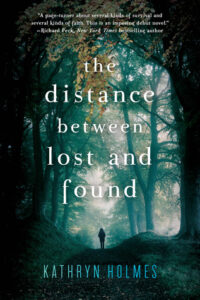The Distance Between Lost and Found, part 2: Sex, Power, Politics and The Church
 It’s interesting how two people can read the same book and have two different experiences with it. When Ally Watkins and I began talking about The Distance Between Lost and Found it became evident that different parts, different themes, stood out to each of us. So whereas Ally talked a lot about the the faith aspects of DBLF, I’m going to talk about something very different, though definitely related to the idea of power in the church.
It’s interesting how two people can read the same book and have two different experiences with it. When Ally Watkins and I began talking about The Distance Between Lost and Found it became evident that different parts, different themes, stood out to each of us. So whereas Ally talked a lot about the the faith aspects of DBLF, I’m going to talk about something very different, though definitely related to the idea of power in the church.
In order to have this conversation, I’m going to have to spill some big reveals. SO DO NOT READ THIS POST UNTIL AFTER YOU HAVE READ THE BOOK.
READ THE BOOK, COME BACK, AND LET’S TALK.
*****SPOILER SPACE*****
******SPOILER SPACE*****
*****SPOILER SPACE*****
When we first meet Hallie, she is at church camp and it is clear that she is being frozen out and bullied, and the freeze out is primarily being led by a boy named Luke Willis. Luke Willis happens to be the preacher’s son, which gives him a de facto position of power in the church youth group. He chooses to use this position of power not for good, but for personal gain. Like many people in positions of power, yes even people in positions of power in the church, he has power and that power is easily abused.
ADVERTISEMENT
ADVERTISEMENT
The basics of the story is that an event has happened between Hallie and Luke and when this event becomes known, Luke’s version of the story is automatically believed over Hallie’s. This is in part because of Luke’s position of power, but I would also argue that it is also in part because Luke is the male in this story and Hallie is the female; culturally we still tend to believe the males over the females, see any recent news headlines or read the comments of any column about feminist issues for ample evidence of this.
It’s also interesting to note that when this book was first recommended to me I asked if it was about sexual violence and I was told no, it was about bullying. But I would argue that there is indeed an element of sexual coercion involved as the events that happen between Luke and Hallie are not rape, per se, but neither are the fully consensual acts. Luke uses a variety of tactics to try and engage Hallie in a physical relationship with him, including some very real emotional coercion. What the event might have turned into we will never know because it is interrupted. But this event is a really strong example of emotional coercion and makes for a good discussion about enthusiastic consent. I would love to see church youth groups read and discuss this book together, I think it would make for a powerful discussion.
I found it interesting that this was presented to me as not a story about sexual violence, when it has many of the hallmarks including emotional manipulation (anger, threats), ignoring her no (he begins taking her bra off even though she has pulled away and expressed that she is not comfortable) and then, later, slut shaming. Because of the way Luke spins the story of what happened that night, Hallie becomes a victim of slut shaming in her youth group and in her home. Though culturally we are still very uncomfortable with female sexuality, this is magnified in the church to the nth degree, particularly when we discuss sex, sexuality, and sexual desires outside of marriage. Like most victims of slut shaming, Hallie goes through a journey of many emotions, including shame, doubt, self-blame, isolation and alienation, and a very understandable questioning of her faith.
In some ways this story reminds me of one of the storylines in Brutal Youth by Anthony Breznican. In the opening scene of BY a young man, hoping to cause a diversion away from a major event happening, runs up and grabs a teacher and kisses her. When the teacher tries to report that she has been the victim of sexual assault to the police they ridicule her, stating that it was merely a kiss and more important things are happening. In a culture that is still fuzzy on what constitutes “legitimate rape”, we do an even worse job of discussing other forms of sexual assault and coercion, which I maintain both of these stories provide examples of. When victims of rape come forward they still have an incredible problem getting the police to investigate the crimes against them, and we do an even worse job of talking about and protecting those who experience situations like those we see here in The Distance Between Lost and Found and Brutal Youth.
The other interesting thing we see happening is the power dynamics of the sexual abuse. Sexual coercion and sexual abuse are not only about sex, they are about power. And this is something Luke has. It’s something he knows will keep him safe. It’s something he knows he can use as a weapon not only to woo girls only to quickly discard them, but something he knows he can use to cover up his transgressions. These are the same power dynamics you see in the sport culture (see Canary by Rachele Alpine for example) and in books like the upcoming All the Rage by Courtney Summers and Every Last Promise by Kristin Hallbrook (both of which I highly recommend).
ADVERTISEMENT
ADVERTISEMENT
Sexual abuse in the church happens. It happens among teens in youth groups. It happens in the pulpits as youth pastors and Sunday school teachers and Priests use their power to abuse the people who trust them to not only guide their spiritual growth, but to keep them safe and guide them away from sin. One of the best books regarding this topic is The Gospel of Winter by Brendan Kiely, a book about the Catholic priest abuse scandal. But there are also elements of this in Faking Normal by Courtney C. Stevens.
The power that these perpetrators has comes not only from their position, but from our unwillingness to believe that these very people that we put our spiritual growth in the hands of are capable of this type of abuse. Surely that person is not capable of these things they have been accused of we think to ourselves, which is part of the reason why almost 30 women can come forward with claims of abuse against men like Bill Cosby and there are still people who think there is no possible way we should maybe, kind of believe that he is in fact capable of that which he has been accused of. And yet the truth is that it is people in positions of power who have not only the most opportunity to abuse, but have the most courage to abuse because they know that their position of power provides them protections that those without that power would have. With great power may come great responsibility, but it can also be said that with great power comes a greater temptation and ability to abuse that power. In the church and in popular culture we make people into idols and we hold onto those idols fiercely, even when they are destroying others around us.
Luke of course is not a pastor or a preacher or a teacher or a priest. He is a teenage boy. But he is, in fact, in a position of power. Even in high school and in church youth groups that proclaim love and acceptance for all there are hierarchies of power. Whatever our intentions may be inside the walls of our churches, we are still a group of fallible human beings gathered together. This is one of the things I loved most about The Distance Between Lost and Found, it highlighted so eloquently that struggle between our human nature and our desire born out of faith to be better. Holmes doesn’t shy away from the idea that even in a church youth group real world dynamics are at play and horrible things happen. These teens grapple with the very same things that non-churched teens grapple with in a high school setting, they just happen to be doing it while on a church camping trip. But these questions are universal: Who am I? What do I believe? What’s my place in this universe? Or in this group? Or in this moment?
Two of my college friends were raped in the church by their Sunday school teachers. Different friends, different churches, different experiences. But in both of these cases, just like in the public school, a person that was entrusted with their care and growth violated that trust in horrific ways. They abused their power. They altered the landscape of their lives, they changed the trajectory of their paths. Things happen in the church and in church youth groups. Sometimes they are indisputable, as my friend’s stories are. Sometimes there is more nuance, as I would argue The Distance Between Lost and Found presents us with. But it is a real reminder that even in our church youth groups, we need to be talking with our teens about what real consent is and what it isn’t. Sexual education makes adults uncomfortable. We don’t want teens to be having sex so we think if we don’t talk about sex with them then they won’t have sex. But the truth is, some teens have sex. All teens think about sex. Even teens who practice any of the various religions out there. The best thing we can do for our teens, even the teens in our churches, is to talk to them about healthy sex and consent. We are losing far too many of our young people to sexual violence, and sometimes that sexual violence is occurring in our churches.
For more on Faith and Spiritulaity in YA Lit, check out our discussion hub here.
For more on Sexual Violence and Teens in YA Lit, check out the #SVYALit Project index here.
Filed under: #FSYALit, #SVYALit, #SVYALit Project, Consent, Faith, Sex, Sex and Sexuality, Sex and Violence, Sexual Coercion, Spiritual Life, Spirituality
About Karen Jensen, MLS
Karen Jensen has been a Teen Services Librarian for almost 30 years. She created TLT in 2011 and is the co-editor of The Whole Library Handbook: Teen Services with Heather Booth (ALA Editions, 2014).
ADVERTISEMENT
ADVERTISEMENT
SLJ Blog Network
2024 Books from Pura Belpré Winners
In Memorium: The Great Étienne Delessert Passes Away
Winnie-The-Pooh | Review
Parsing Religion in Public Schools
ADVERTISEMENT







